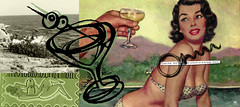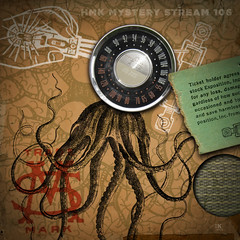Adios CBGB's

Just after 1 a.m. on Monday morning, the last notes of live music rang from the stage of CBGB & OMFUG, the Bowery club where punk-rock invented itself. Patti Smith finished the club's final concert with her ballad "Elegie," growing teary-eyed as she read a list of dead punk-rock musicians and advocates. But just before it, she had worked up a galvanizing crescendo -- from poetry recitation to rock song to guitar-charged incantation -- in a medley of "Horses" and "Gloria," proclaiming with a triumphant rasp, "Jesus died for somebody's sins/But not for CBGB's."
The songs came from her debut album, "Horses," which was released in 1975, when Ms. Smith and CBGB were making each other famous. She was a poet turned rocker, tapping and then redoubling the energy she found in basic three-chord songs. The club -- its initials mean Country Bluegrass Blues and Other Music for Uplifting Gormandizers -- was a hangout in a dire location. But its owner, Hilly Kristal, agreed to book artistically ambitious, high-concept, generally primitivist bands that defied the commercial imperatives of early-1970's rock. It was a neighborhood place in a low-rent neighborhood that happened to house artists and derelicts side by side, inspiring some hard-nosed art. During her set, Ms. Smith described CBGB as, "This place that Hilly so generously offered to us to create new ideas, to fail, to make mistakes, to reach new heights."
In some ways CBGB, which opened in December 1973, ended its life as it had started. It never moved from its initial location, which was originally under a Bowery flophouse, now a homeless shelter. It never changed its floor plan, with a long bar lit by neon beer signs on the way to an uneven floor, a peeling ceiling, a peculiarly angled stage and notorious bathrooms. Through the years, the sound system was improved until its clean roar could make any power chord sound explosive. Mostly, however, CBGB just grew more encrusted: with dust, with band posters stuck on every available surface, with bodily fluids from performers and patrons. Ms. Smith did some casual spitting of her own during her set.
But in a historical long shot, CBGB got lucky. The concepts of bands booked there turned out to be durable ones: Ms. Smith's blunt, visionary and primal songs; Talking Heads' nervously oblique funk, and especially the Ramones' terse, blaring, catchy rockers, which came to define punk-rock. Having nurtured bands like those--and later post-punk bands from Sonic Youth to Living Colour--CBGB became a rock landmark. Its reputation grew strong enough to coast on. Even as its regular bookings grew far less selective through the 1990's and 2000's, every now and then a big-name band would play there as a pilgrimage.
Yet CBGB remained a neighborhood joint. The club's last show wasn't some stage-managed, all-star sendoff destined to be a television special (although it was broadcast live on Sirius satellite radio.) It was just two sets by Ms. Smith with her band and two guests: Flea, the bassist from the Red Hot Chili Peppers, and Richard Lloyd, one of the two guitarists in Television, the band whose early gigs defined CBGB. Ms. Smith's sets included Television's "Marquee Moon," with Mr. Lloyd, and songs from other CBGB bands: Blondie's hit "The Tide is High," the Dead Boys' "Sonic Reducer" and a Ramones medley sung by her guitarist, Lenny Kaye, who changed the lyrics of "Do You Remember Rock and Roll Radio?" from "It's the end of the century" to "It's the end of CBGB." Ms. Smith was ignoring one of Mr. Kristal's early conditions for CBGB bands--that they only perform their own songs--but forgivably.
The end of a long and painful denouement for a punk-rock institution.
Punk-rock never promised that it was built to last. The songs always seemed ready to self-destruct; simple and brief, they were often just three chords and a burst of frustration or pugnacity or humor. Some of the musicians were self-destructive, too. Yet punk, as codified by the Ramones, has turned out to fulfill some perennial adolescent need, and it persisted. Bands kept coming along and embracing it, some lasting just long enough for a few local gigs--and possibly a set on one of CBGB's nightly septuple bills--and others becoming the first step for musicians who would go on to bigger things. Punk infiltrated a suburban underground in the 1980's, created its own do-it-yourself circuit, and eventually emerged as million-selling punk-pop in the 1990's. Improbably, CBGB persisted too: an institution built on music that originally sought to topple institutions.
It's a shame to lose any working club in New York City with so much history and, even rarer, such outstanding sound. The prospect of a recreated CBGB in Las Vegas, even with original artifacts, can't make up for it; Las Vegas isn't in the neighborhood. But CBGB did its job so well it created its own competition and heirs. Bands whose music is based on what came out of CBGB in the 1970's perform everywhere from the Mercury Lounge to Madison Square Garden. The closing of CBGB is the end of a lovable chunk of New York City real estate, but it's far from the end of an era. After a yearlong goodbye--since CBGB's disputes with its landlord, the nonprofit Bowery Residents' Committee, first surfaced in 2005--too much mourning is unnecessary.
"Kids, they'll find some other club," Ms. Smith insisted during her set. "You just got a place, just some crappy place, that nobody wants, and you got one guy who believes in you, and you just do your thing. And anybody can do that, anywhere in the world, any time."
After her set was over and the club had partly cleared out, Ms. Smith returned to the stage for a silent postcript. As fans held up outstretched hands, Ms. Smith reached into a bag and handed out little black pins. They read, "What remains is future."
Thanks to By Jon Pereles


















